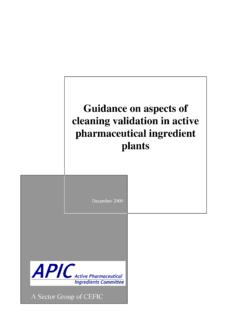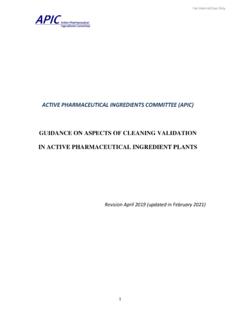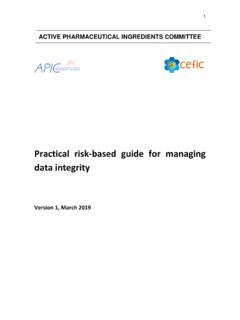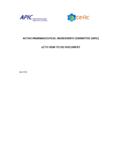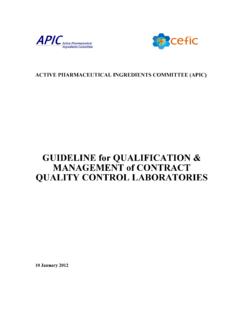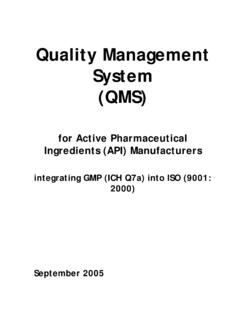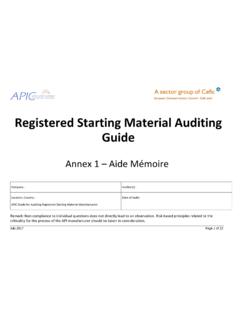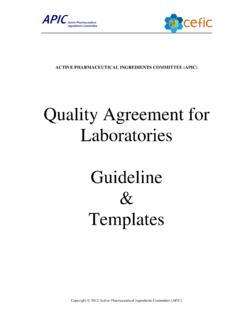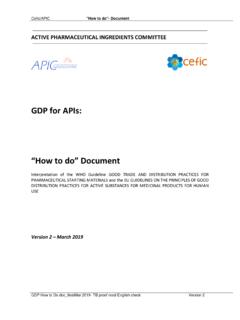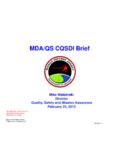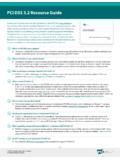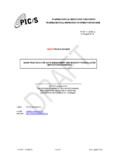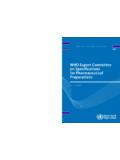Transcription of GUIDANCE ON ASPECTS OF CLEANING …
1 CONFIDENTIAL 1 Revision September 2016 ACTIVE PHARMACEUTICAL INGREDIENTS COMMITTEE (APIC) GUIDANCE ON ASPECTS OF CLEANING validation IN ACTIVE PHARMACEUTICAL INGREDIENT PLANTS CONFIDENTIAL 2 Table of Contents FOREWORD OBJECTIVE SCOPE ACCEPTANCE CRITERIA Introduction Methods of Calculating Acceptance Criteria Acceptance criteria using health-based data Acceptance criteria based on Therapeutic Daily Dose Acceptance criteria based on LD50 General Limit as acceptance criteria Swab Limits Rinse Limits Rationale for the use of different limits in pharmaceutical and chemical production LEVELS OF CLEANING Introduction CLEANING Levels
2 CLEANING Verification/ validation CONTROL OF CLEANING PROCESS BRACKETING AND WORST CASE RATING Introduction Bracketing Procedure CLEANING Procedures Worst Case Rating DETERMINATION OF THE AMOUNT OF RESIDUE Introduction validation Requirements Sampling Methods Analytical Methods CLEANING validation PROTOCOL Background Purpose Scope Responsibility CONFIDENTIAL 3 Sampling Procedure Testing procedure Acceptance criteria Deviations Revalidation validation QUESTIONS REFERENCES GLOSSARY COPYRIGHT AND DISCLAIMER CONFIDENTIAL 4 FOREWORD This GUIDANCE document was updated in 2014 by the APIC CLEANING validation Task Force on behalf of the Active Pharmaceutical Ingredient Committee (APIC) of CEFIC.
3 The Task Force members were: - Annick Bonneure, APIC, Belgium - Tom Buggy, DSM Sinochem Pharmaceuticals, the Netherlands - Paul Clingan, MacFarlan Smith, UK - Anke Grootaert, Janssen Pharmaceutica, Belgium - Peter Mungenast, Merck KGaA, Germany. - Luisa Paulo, Hovione FarmaCiencia SA, Portugal - Filip Quintiens, Genzyme, Belgium - Claude Vandenbossche, Ajinomoto Omnichem, Belgium - Jos van der Ven, Aspen Oss , the Netherlands - Stefan Wienken, BASF, Germany With support and review from: - Pieter van der Hoeven, APIC, Belgium - Anthony Storey, Pfizer, UK - Rainer Fendt, BASF, Germany A further revision of the GUIDANCE document has now been done in 2016 to bring it in line with the European Medicines Agency GUIDANCE on use of Health Based data to set acceptance criteria for CLEANING .
4 The main changes were introduced in Chapter 4, Acceptance Criteria. The subject of CLEANING validation in active pharmaceutical ingredient manufacturing plants has continued to receive a large amount of attention from regulators, companies and customers alike. The integration of CLEANING validation within an effective Quality System supported by Quality Risk Management Processes should give assurance that API Manufacturing Operations are performed in such a way that Risks to patients related to CLEANING validation are understood, assessed for impact and are mitigated as necessary.
5 It is important that the requirements for the finished manufacturing companies are not transferred back in the process to active pharmaceutical ingredient manufacturers without consideration for the different processes that take place at this stage. For example, higher limits may be acceptable in chemical production compared to pharmaceutical production because the carry-over risk is much lower for technical and chemical manufacturing reasons The document reflects the outcome of discussions between APIC member companies on how CLEANING validation requirements could be fulfilled and implemented as part of routine operations.
6 CONFIDENTIAL 5 In addition, APIC has aligned this GUIDANCE with the ISPE Risk MaPP Guide1 that follows the Quality Risk Management Processes as described in the ICH Q9 GUIDANCE on Quality Risk Management. A further revision of the GUIDANCE has now been done to include the general principles of the EMA Guideline2 on setting health based exposure limits for determining safe threshold values for the CLEANING of API s in shared facilities. The criteria of Acceptable Daily Exposure (ADE) or Permitted Daily Exposure (PDE) are recommended to be used by companies to decide if Dedicated Facilities are required or not and to define the Maximum Acceptable Carry Over (MACO) of API s in particular, in Multi-Purpose Equipment.
7 Chapter 6 defines factors that should be considered in controls of the CLEANING processes to manage the risks related to potential chemical or microbiological contamination. The PDA Technical Report No. 29 Points to Consider for CLEANING Validation3 is also recommended as a valuable GUIDANCE document from industry. The following topics are discussed in the PDA document: CLEANING process (CIP/COP): design and qualification - Types of residues, setting acceptance criteria, sampling and analytical methods - Maintenance of the validated state: critical parameters measurements, process alarms, change control, trending & monitoring, training and periodic review - Documentation Objective This document has been prepared to assist companies in the formulation of CLEANING validation programmes and should not be considered as a technical standard but a starting 1 ISPE Baseline Pharmaceutical Engineering Guide, Volume 7 Risk-Based Manufacture of Pharmaceutical Products, International Society for Pharmaceutical Engineering (ISPE)
8 , First Edition, September 2010, 2 European Medicines Agency, EMA/CHMP/CVMP/SWP/169430/2012, Guideline on setting health based exposure limits for use in risk identification in the manufacture of different medicinal products in shared facilities. 3 Parenteral Drug Association (PDA) GUIDANCE for Industry. Technical Report No. 29 (Revised 2012) Points to Consider for CLEANING validation , Destin A. LeBlanc, Gretchen Allison, Jennifer L. Carlson, Koshy George, Igor Gorsky, Irwin S. Hirsh, Jamie Osborne, Greg Randall, Pierre-Michel Riss, George Verghese, Jenn Walsh, Vivienne Yankah.
9 CONFIDENTIAL 6 point for internal discussions. The document includes examples on how member companies have dealt with specific areas and issues that arise when performing CLEANING validation . Scope Six specific areas are addressed in this GUIDANCE document: Acceptance Criteria Levels of CLEANING Control of the CLEANING process Bracketing and Worst Case Rating Determination of the amount of residue CLEANING validation Protocol Finally, the most frequently asked questions are answered to give further GUIDANCE on specific points related to CLEANING validation . Acceptance Criteria Introduction Companies must demonstrate during validation that the CLEANING procedure routinely employed for a piece of equipment limits potential carryover to an acceptable level.
10 The limits established must be calculated based on sound scientific rational. This section provides practical GUIDANCE as to how those acceptance criteria can be calculated. It is important that companies evaluate all cases individually. There may be specific instances where the product mix in the equipment requires further consideration. The acceptance criteria preferably should be based on the Acceptable Daily Exposure (ADE) or Permitted Daily Exposure (PDE) calculations whenever this data is available. The APIC GUIDANCE refers primarily to ADE in the examples of calculations included in this chapter, in line with the ISPE recommended calculations.
